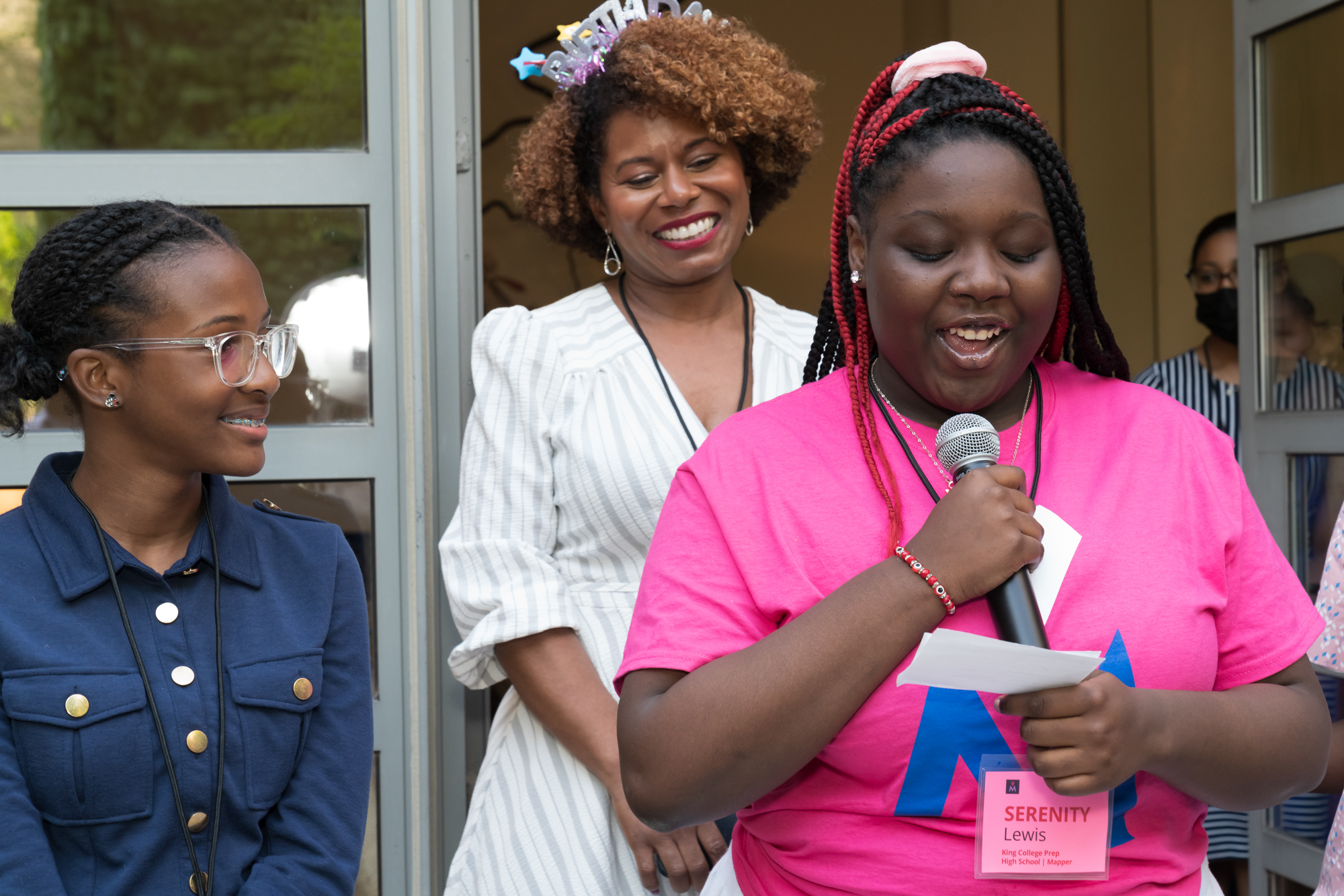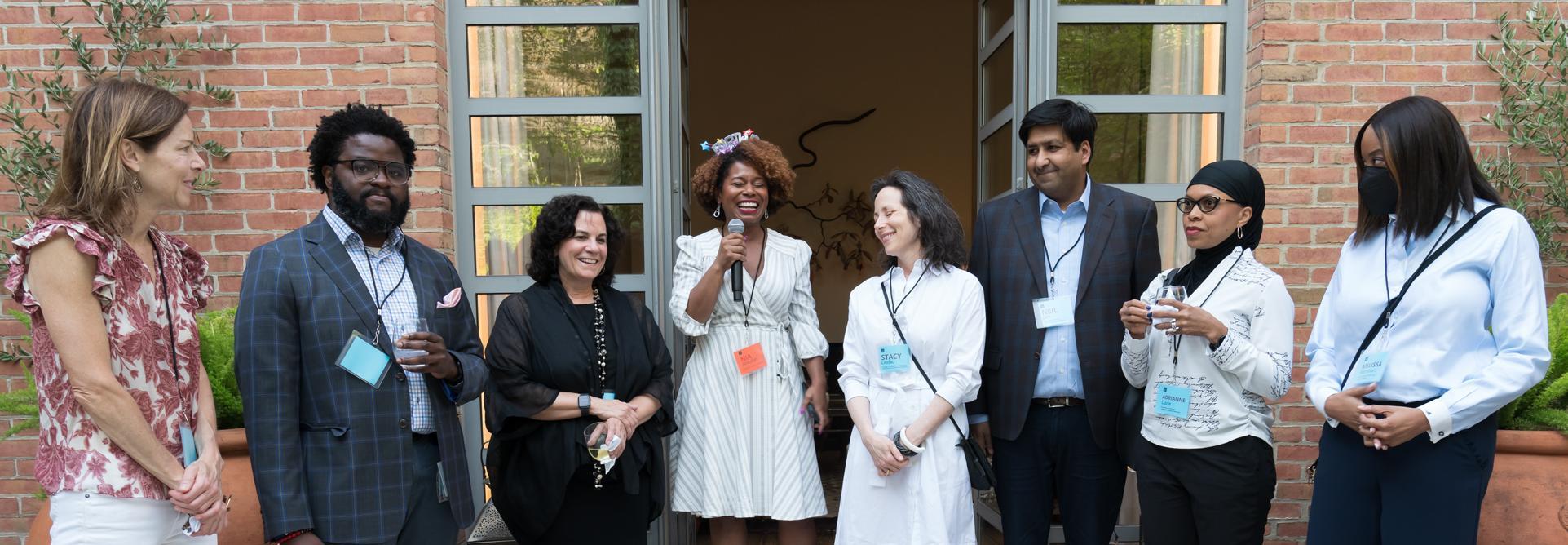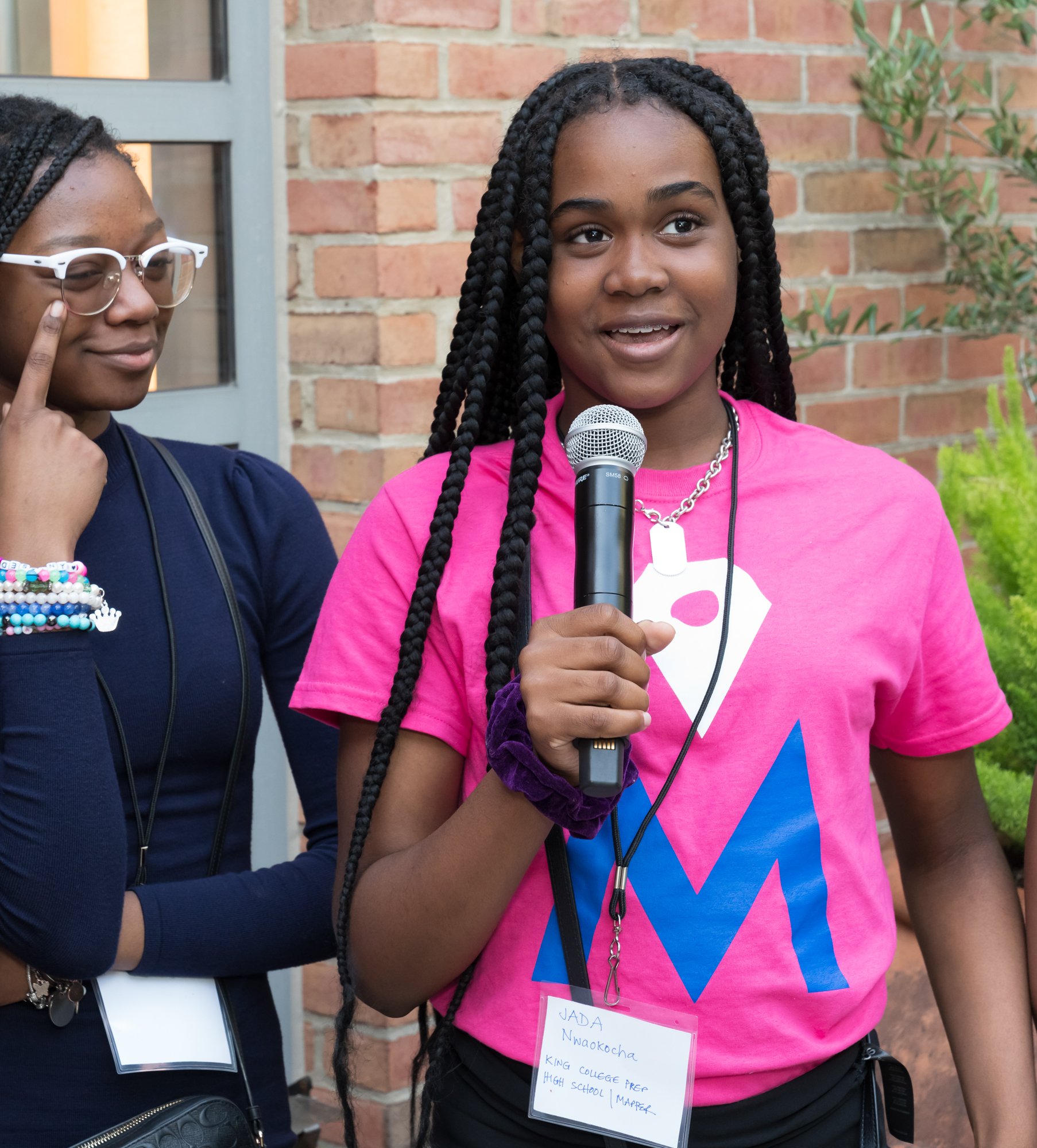Creating Pathways to STEM Careers for Black and Latinx Students

STEM careers are growing fast. People of color have long been underrepresented in those careers. A series of programs and initiatives, collectively known as Project SOUL, aims to close the gap.
Science, technology, engineering, and mathematics (STEM) careers are a large and growing share of the U.S. workforce. In 2019, the STEM workforce accounted for as much as 23 percent of the total U.S. workforce. STEM occupations are anticipated to only continue rising. According to the U.S. Bureau of Labor Statistics, STEM occupations will grow eight percent by 2029. These careers are also often well-compensated with the median STEM worker earning nearly 50 percent more than that of non-STEM workers.
People of color, however, are underrepresented in STEM careers. While Hispanic people make up 17 percent of the U.S. workforce, for example, they only represent 8 percent of the STEM workforce. Further, Black people comprise 11 percent of the U.S. workforce, but represent just 9 percent of the STEM workforce and hold only 6 percent of life and physical sciences jobs and 5 percent of engineering jobs.
The reasons for the Black and Hispanic representation gaps are multifaceted resulting in challenges associated with attracting more people into STEM and retaining those who enter. Many Black people working in STEM cite discrepancies in access to quality education, recruitment opportunities, promotions, or a lack of encouragement from an early age. Black and Hispanic college graduates are underrepresented in STEM fields.
The Institute for Racial Justice (IRJ) is working to close the representation gap with Project STEM for Overlooked and Underserved Learners, or Project SOUL.
Instead of addressing just one of these issues, Project SOUL is designing and implementing a comprehensive approach. It encompasses a series of initiatives and programs, many developed with community partners, to engage and create pathways for Black and Hispanic youth from middle school through graduate school and into STEM careers.

For example, at the K-12 level, the Men of Math (M2) Fellowship, in partnership with My Brother's Keeper Chicago, brought together a cohort of Black and Hispanic male math instructors. The purpose was to build a nurturing community of practice and to increase the level of culturally-informed teaching. IRJ was recently awarded additional funding from the McDougal Family Foundation to expand M2 for the upcoming academic year.
At the collegiate level, in partnership with Arrupe College, IRJ sent two students to the University of Iowa to participate in their Summer Training Program in Cancer research. This program, called Study the U.S., is IRJ's attempt to expose undergraduate students to research experiences at colleges and communities beyond Chicago. Also, five students from Lincoln University, a historically Black college and university (HBCU), worked alongside IRJ Joint Faculty Member Whelton Miller and other data science faculty in research labs at the Health Science Campus in Maywood, Illinois.
Data Science for the Common Good, is the Institute’s most comprehensive STEM initiative. It connects Loyola faculty, graduate students, and undergraduates with MAPSCorps, a local community organization that empowers middle and high school students with practical data science skills. The partnership is designed to empower youth with science and technology skills while generating community-informed insights.
Last summer, Loyola University Chicago undergraduate students worked with a group of Chicago high school students to examine Bronzeville’s history, resources, and public health outcomes. Together, they poured through research and existing data and created their own — capturing data about every public-facing building and organization in the neighborhood. The high school students created a policy proposal, which they presented at the end of the six-week program through the Centers for New Horizons, recommending the creation of a new community center offering robust mental health support services the neighborhood currently lacks.
“[The Loyola students] helped the young people understand the history of Bronzeville and then look at the public health outcomes of the community in comparison to other communities in Chicago to look for relationships between asset deficits and public health threats,” said Dr. Nia Abdullah, executive director of MAPSCorps.

“They learned about the history of Bronzeville since deindustrialization that included public housing being torn down and racial covenants that didn't allow Black people to purchase outside of certain communities. Then they used the Chicago Health Atlas to understand the public health outcomes in that community in comparison to other communities.”
The summer session was so successful that the National Science Foundation awarded IRJ a grant to expand this work into the school year, including an after-school program focused on research methodologies and policy advocacy.
"I worried, 'Oh, this is going to be too boring for [high school students.] It's going to be after school, and they're not going to be interested.' But they were so excited because they're helping their community. And they get to use their own expertise, they're able to engage in all these great skills, and they get agency and confidence,” Abdullah said.
The following fall, IRJ Faculty Affiliate Carolyn Tang Kmet, a senior lecturer at the Quinlan School of Business, took the data gathered by the Loyola and MAPSCorps students and developed a semester-long graduate course project. Students learned to merge the MAPSCorps data with other public data sets to identify opportunities for further collaboration between the university and historically marginalized Chicagoland communities.

"Because this is actual, real data with a purpose — gathered by high school students working as MAPSCorps summer interns — my graduate students do get very invested in it. It has been a source of pride for me to see how much they care about this.”
This pilot program was just the beginning. With the National Science Foundation grant, the program will incorporate more MAPSCorps students, Loyola undergraduate students, and a postdoctoral fellow. The project, just one of the Institute's ongoing community-university partnerships, exemplifies IRJ’s scope of impact, multipronged approach, and emphasis on scaffolding pathways.
The scaffolding works by funneling information and mentorship in both directions throughout a project. Middle and high school students work on the ground in their communities as data collectors, alongside undergraduate students as near-peer mentors. Graduate students use the data collected to make recommendations and mentor undergraduate students. Postdoctoral fellows take the graduate students’ work, mentor graduate students, and serve as project leads. Faculty affiliates mentor postdoctoral fellows and lend their expertise to the projects.
“IRJ is in the very early stages of developing multifaceted approaches to solving complex programs. One of the most stubborn is that of Black and Latinx talent finding support and a sense of belonging in STEM courses, majors, and careers,” said Dr. Malik Henfield, founding dean of the IRJ. “As we deepen our relationships and broaden our partnerships in Chicago and beyond, we will continue working towards equitable representation in STEM."
STEM careers are growing fast. People of color have long been underrepresented in those careers. A series of programs and initiatives, collectively known as Project SOUL, aims to close the gap.
Science, technology, engineering, and mathematics (STEM) careers are a large and growing share of the U.S. workforce. In 2019, the STEM workforce accounted for as much as 23 percent of the total U.S. workforce. STEM occupations are anticipated to only continue rising. According to the U.S. Bureau of Labor Statistics, STEM occupations will grow eight percent by 2029. These careers are also often well-compensated with the median STEM worker earning nearly 50 percent more than that of non-STEM workers.
People of color, however, are underrepresented in STEM careers. While Hispanic people make up 17 percent of the U.S. workforce, for example, they only represent 8 percent of the STEM workforce. Further, Black people comprise 11 percent of the U.S. workforce, but represent just 9 percent of the STEM workforce and hold only 6 percent of life and physical sciences jobs and 5 percent of engineering jobs.
The reasons for the Black and Hispanic representation gaps are multifaceted resulting in challenges associated with attracting more people into STEM and retaining those who enter. Many Black people working in STEM cite discrepancies in access to quality education, recruitment opportunities, promotions, or a lack of encouragement from an early age. Black and Hispanic college graduates are underrepresented in STEM fields.
The Institute for Racial Justice (IRJ) is working to close the representation gap with Project STEM for Overlooked and Underserved Learners, or Project SOUL.
Instead of addressing just one of these issues, Project SOUL is designing and implementing a comprehensive approach. It encompasses a series of initiatives and programs, many developed with community partners, to engage and create pathways for Black and Hispanic youth from middle school through graduate school and into STEM careers.

For example, at the K-12 level, the Men of Math (M2) Fellowship, in partnership with My Brother's Keeper Chicago, brought together a cohort of Black and Hispanic male math instructors. The purpose was to build a nurturing community of practice and to increase the level of culturally-informed teaching. IRJ was recently awarded additional funding from the McDougal Family Foundation to expand M2 for the upcoming academic year.
At the collegiate level, in partnership with Arrupe College, IRJ sent two students to the University of Iowa to participate in their Summer Training Program in Cancer research. This program, called Study the U.S., is IRJ's attempt to expose undergraduate students to research experiences at colleges and communities beyond Chicago. Also, five students from Lincoln University, a historically Black college and university (HBCU), worked alongside IRJ Joint Faculty Member Whelton Miller and other data science faculty in research labs at the Health Science Campus in Maywood, Illinois.
Data Science for the Common Good, is the Institute’s most comprehensive STEM initiative. It connects Loyola faculty, graduate students, and undergraduates with MAPSCorps, a local community organization that empowers middle and high school students with practical data science skills. The partnership is designed to empower youth with science and technology skills while generating community-informed insights.
Last summer, Loyola University Chicago undergraduate students worked with a group of Chicago high school students to examine Bronzeville’s history, resources, and public health outcomes. Together, they poured through research and existing data and created their own — capturing data about every public-facing building and organization in the neighborhood. The high school students created a policy proposal, which they presented at the end of the six-week program through the Centers for New Horizons, recommending the creation of a new community center offering robust mental health support services the neighborhood currently lacks.
“[The Loyola students] helped the young people understand the history of Bronzeville and then look at the public health outcomes of the community in comparison to other communities in Chicago to look for relationships between asset deficits and public health threats,” said Dr. Nia Abdullah, executive director of MAPSCorps.

“They learned about the history of Bronzeville since deindustrialization that included public housing being torn down and racial covenants that didn't allow Black people to purchase outside of certain communities. Then they used the Chicago Health Atlas to understand the public health outcomes in that community in comparison to other communities.”
The summer session was so successful that the National Science Foundation awarded IRJ a grant to expand this work into the school year, including an after-school program focused on research methodologies and policy advocacy.
"I worried, 'Oh, this is going to be too boring for [high school students.] It's going to be after school, and they're not going to be interested.' But they were so excited because they're helping their community. And they get to use their own expertise, they're able to engage in all these great skills, and they get agency and confidence,” Abdullah said.
The following fall, IRJ Faculty Affiliate Carolyn Tang Kmet, a senior lecturer at the Quinlan School of Business, took the data gathered by the Loyola and MAPSCorps students and developed a semester-long graduate course project. Students learned to merge the MAPSCorps data with other public data sets to identify opportunities for further collaboration between the university and historically marginalized Chicagoland communities.

"Because this is actual, real data with a purpose — gathered by high school students working as MAPSCorps summer interns — my graduate students do get very invested in it. It has been a source of pride for me to see how much they care about this.”
This pilot program was just the beginning. With the National Science Foundation grant, the program will incorporate more MAPSCorps students, Loyola undergraduate students, and a postdoctoral fellow. The project, just one of the Institute's ongoing community-university partnerships, exemplifies IRJ’s scope of impact, multipronged approach, and emphasis on scaffolding pathways.
The scaffolding works by funneling information and mentorship in both directions throughout a project. Middle and high school students work on the ground in their communities as data collectors, alongside undergraduate students as near-peer mentors. Graduate students use the data collected to make recommendations and mentor undergraduate students. Postdoctoral fellows take the graduate students’ work, mentor graduate students, and serve as project leads. Faculty affiliates mentor postdoctoral fellows and lend their expertise to the projects.
“IRJ is in the very early stages of developing multifaceted approaches to solving complex programs. One of the most stubborn is that of Black and Latinx talent finding support and a sense of belonging in STEM courses, majors, and careers,” said Dr. Malik Henfield, founding dean of the IRJ. “As we deepen our relationships and broaden our partnerships in Chicago and beyond, we will continue working towards equitable representation in STEM."
